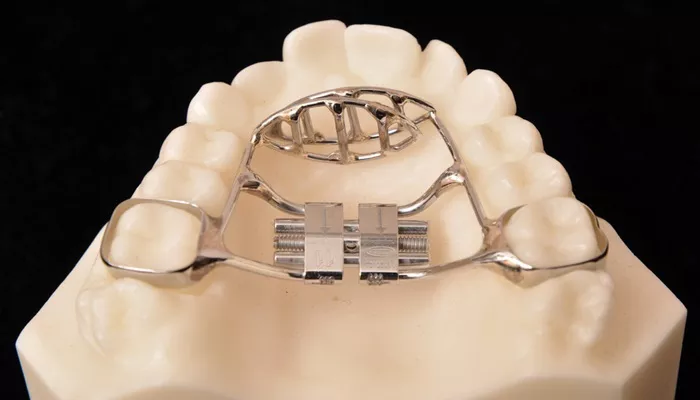Dental expanders are orthodontic devices used to widen the upper jaw (maxilla) to create more space for teeth, improve bite alignment, and enhance overall oral health. They are commonly used in children and adolescents, as their jaws are still developing. While dental expanders can be highly effective in achieving desired results, regular adjustments are necessary to ensure they function correctly and achieve optimal outcomes. In this article, we will explore the purpose of dental expanders, how to adjust them, and important considerations for both patients and dental professionals.
What Are Dental Expanders?
Dental expanders are appliances typically made from metal and acrylic. They are custom-fitted to the patient’s mouth and are attached to the molars using bands or brackets. The primary function of a dental expander is to gradually widen the upper jaw by applying gentle pressure to the teeth and surrounding bone. This process can help address various orthodontic issues, including:
Crowded Teeth: When there is insufficient space in the mouth for all teeth to align properly, expanders can create the necessary room.
Crossbite: A crossbite occurs when the upper teeth do not properly align with the lower teeth. Expanders can help correct this misalignment.
Narrow Palate: A narrow palate can lead to difficulties in chewing and speaking. Expanders can widen the palate to improve function.
Facial Aesthetics: Expanding the upper jaw can enhance facial symmetry and aesthetics.
see also: How Long Is The Tads Treatment Orthodontic?
The Importance of Adjustments
Adjustments to dental expanders are essential for several reasons:
Controlled Expansion: The adjustment process allows for controlled and gradual widening of the jaw. This helps to minimize discomfort and reduce the risk of complications.
Monitoring Progress: Regular adjustments enable the orthodontist to monitor the patient’s progress. This ensures that the expander is functioning as intended and that the desired results are being achieved.
Patient Comfort: Adjustments can help alleviate any discomfort or pressure that may arise during the expansion process.
Preventing Complications: Regular adjustments help identify any issues early on, such as improper fitting or excessive pressure, which can prevent complications down the line.
How to Adjust Dental Expanders
Adjusting dental expanders should always be performed by a qualified orthodontist or dental professional. However, understanding the general process can help patients and their families feel more informed and prepared. Here is a step-by-step guide on how dental expanders are adjusted:
Step 1: Initial Assessment
Before making any adjustments, the orthodontist will conduct an initial assessment. This includes:
Reviewing Patient History: The orthodontist will review the patient’s dental history, treatment goals, and any concerns the patient may have.
Clinical Examination: A thorough examination of the expander, teeth, and gums will be conducted to ensure everything is in good condition.
X-rays: If necessary, X-rays may be taken to assess the development of the jaw and teeth.
Step 2: Determining the Adjustment Schedule
The orthodontist will determine how often adjustments should be made. Typically, adjustments are scheduled every 1 to 2 weeks, depending on the individual needs of the patient and the specific treatment plan.
Step 3: Using the Activation Key
Most dental expanders come with a small key or tool used to activate the device. The orthodontist will use this key to make adjustments.
Here’s how it works:
Locate the Activation Hole: The orthodontist will locate the activation hole on the expander. This hole is usually found in the center of the device.
Insert the Key: The orthodontist will insert the activation key into the hole. The key is designed to fit snugly, allowing for precise adjustments.
Turn the Key: The orthodontist will turn the key in the appropriate direction (usually clockwise) to activate the expander.
This action will widen the expander by a specific amount, typically 0.5 mm to 1 mm per turn.
Step 4: Monitoring Patient Response
After making the adjustment, the orthodontist will monitor the patient’s response. This includes:
Assessing Comfort: The orthodontist will ask the patient about any discomfort or pain following the adjustment. It is normal to experience some pressure, but excessive pain should be addressed.
Checking Fit: The orthodontist will ensure that the expander fits properly and is not causing any irritation to the gums or cheeks.
Step 5: Providing Care Instructions
After the adjustment, the orthodontist will provide the patient with care instructions. This may include:
Oral Hygiene: Patients should be reminded to maintain excellent oral hygiene, as dental expanders can make brushing and flossing more challenging.
Dietary Recommendations: Patients may be advised to avoid sticky or hard foods that could dislodge or damage the expander.
Monitoring for Issues: Patients should be instructed to report any unusual symptoms, such as excessive pain, difficulty swallowing, or changes in speech.
Important Considerations for Patients
Patience is Key: The process of expanding the jaw takes time. Patients should be patient and understand that results may not be immediate.
Follow-Up Appointments: Regular follow-up appointments are crucial for monitoring progress and making necessary adjustments.
Communication: Open communication with the orthodontist is essential. Patients should feel comfortable discussing any concerns or discomfort they may experience.
Understanding the Timeline: The duration of treatment with a dental expander varies. It can range from a few months to over a year, depending on the individual case.
Conclusion
Adjusting dental expanders is a critical component of orthodontic treatment aimed at improving dental alignment and overall oral health. Understanding the adjustment process can empower patients and their families to be proactive in their care. While the timeline for treatment varies, regular adjustments, open communication with the orthodontist, and diligent oral hygiene practices are essential for achieving the best results.

